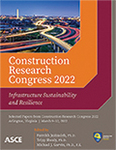Managing Leakages in Intermittent Water Supply Systems: The Role of Network Zoning and Supply Scheduling
Publication: Construction Research Congress 2022
ABSTRACT
Intermittent water supply (IWS) systems serve millions of people around the world. In many IWS systems, water supply through the piped network is rationed among sub-zones in the network following different scheduling schemes. When defining supply zones and developing their supply scheduling, utilities often aim to maximize users’ demand satisfaction while minimizing operating costs, with little attention given to the issue of water loss due to leakages. In this paper, we study the relationship of network zoning (and supply scheduling) with water losses through leakages in the network. A hydraulic model is developed to simulate the performance of IWS networks with the consideration of network leakages. The model is used to explore different variations of network zoning and/or supply scheduling for zones, subject to the operational feasibility of zones’ isolation valves. The model is demonstrated in a real network of a city in the Middle East. The results of the study show how changing network zones and/or their supply scheduling affects leakage rates, demand satisfaction, and supply efficiency. It was found that changing the supply schedule could save up to 22% of the leaked water while maintaining the same level of household demand satisfaction. The developed model can assist water utilities in reducing the non-revenue water due to leakages resulting in improved financial efficiency.
Get full access to this article
View all available purchase options and get full access to this chapter.
REFERENCES
Al-Ghamdi, A. S. (2011). “Leakage-pressure relationship and leakage detection in intermittent water distribution systems.” Journal of Water Supply: Research and Technology - AQUA, 60(3), 178–183.
Al-Washali, T., Sharma, S., Al-Nozaily, F., Haidera, M., and Kennedy, M. (2019). “Monitoring nonrevenue water performance in intermittent supply.” Water (Switzerland), MDPI AG, 11(6).
Ameyaw, E. E., Memon, F. A., and Bicik, J. (2013). “Improving equity in intermittent water supply systems.” Journal of Water Supply: Research and Technology - AQUA, 62(8), 552–562.
AWWA Water Loss Control Committee. (2003). “Committee Report: Applying worldwide BMPs in water loss control.” Journal AWWA, 95(8), 65–79.
Beuken, R. H. S., Lavooij, C. S. W., Bosch, A., and Schaap, P. G. (2007). “Low leakage in the Netherlands confirmed.” 8th Annual Water Distribution Systems Analysis Symposium 2006, 40941(March 2008), 174.
Charalambous, B., and Laspidou, C. (2017). “Dealing with the Complex Interrelation of Intermittent Supply and Water Losses.” Water Intelligence Online, 16(October 2016), 9781780407074.
Ekmekcioğlu, Ö., Başakin, E. E., and Özger, M. (2020). “Discharge coefficient equation to calculate the leakage from pipe networks.” Journal of the Institute of Science and Technology, 10(3), 1737–1746.
Farley, M. (2001). “Leakage Management and Control: a Best Practice Training Manual” World Health Orgnization, 1–98.
Ilaya-Ayza, A. E., Benítez, J., Izquierdo, J., and Pérez-García, R. (2017). “Multi-criteria optimization of supply schedules in intermittent water supply systems.” Journal of Computational and Applied Mathematics, 309, 695–703.
Kaminsky, J., and Kumpel, E. (2018). “Dry pipes: Associations between utility performance and intermittent piped water supply in low and middle income countries.” Water (Switzerland), MDPI AG, 10(8).
Klingel, P. (2012). “Technical causes and impacts of intermittent water distribution.” Water Science and Technology: Water Supply, 12(4), 504–512.
Klise, K. A., Bynum, M., Moriarty, D., and Murray, R. (2017). “A software framework for assessing the resilience of drinking water systems to disasters with an example earthquake case study.” Environmental Modelling and Software, Elsevier Ltd, 95, 420–431.
Lifshitz, R., and Ostfeld, A. (2018). “Clustering for Analysis of Water Distribution Systems.” Journal of Water Resources Planning and Management. 144. https://doi.org/10.1061/(ASCE)WR.1943-5452.0000917.
Mohapatra, S., Sargaonkar, A., and Labhasetwar, P. K. (2014). “Distribution network assessment using EPANET for intermittent and continuous water supply.” Water Resources Management, 28, 3745–3759.
Information & Authors
Information
Published In
History
Published online: Mar 7, 2022
Authors
Metrics & Citations
Metrics
Citations
Download citation
If you have the appropriate software installed, you can download article citation data to the citation manager of your choice. Simply select your manager software from the list below and click Download.
